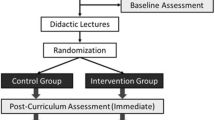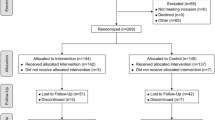Abstract
Background
The Society of American Gastrointestinal and Endoscopic Surgeons (SAGES) has developed the fundamental use of surgical energy (FUSE) didactic curriculum in order to further understanding of the safe use of surgical energy. The virtual electrosurgical skill trainer (VEST) is being developed as a complementary simulation-based curriculum, with several modules already existing. Subsequently, a new VEST module has been developed about dispersive electrode placement. The purpose of this study is to assess knowledge about dispersive electrode placement in surgeons and surgical trainees in addition to describing a new VEST module.
Methods
Forty-six subjects (n = 46) were recruited for participation at the 2016 SAGES conference Learning Center. Subjects were asked to complete demographic surveys, a five-question pre-test, and a five-question post-test after completing the VEST dispersive electrode module. Subjects were then asked to rate different aspects of the module using a five-point Likert scale questionnaire.
Results
Mean pre-simulator and post-simulator assessment scores were 1.5 and 3.4, respectively, with Wilcoxon signed rank analysis showing a significant difference in the means (p < 0.05). Subjects were grouped by the presence (n = 12) or absence (n = 31) of prior FUSE experience and by training level. Mann–Whitney U testing showed no significant difference in pre-simulator assessment scores between attending surgeons and trainees (p > 0.05). In those with and without FUSE exposure, a significant difference (p < 0.05) was seen in pre-simulator assessment scores, and no significant difference in Likert scale assessment scores was seen.
Conclusions
This study demonstrated a new VEST educational module. Consistently high Likert assessment scores showed that users felt that the VEST module helped their understanding of dispersive electrode placement. Additionally, the study reflected a potential knowledge deficit in the safe use of dispersive electrodes in the surgical community, also demonstrating that even some exposure to the FUSE curriculum developed by SAGES provides increased awareness about dispersive electrode use.

Similar content being viewed by others
References
Sankaranarayanan G, Resapu RR, Jones DB, Schwaitzberg S, De S (2013) Common uses and cited complications of energy in surgery. Surg Endosc 27:3056–3072
Overbey DM, Townsend NT, Chapman BC, Bennett DT, Foley LS, Rau AS, Yi JA, Jones EL, Stiegmann GV, Robinson TN (2015) Surgical energy-based device injuries and fatalities reported to the food and drug administration. J Am Coll Surg 221:197–205 e191
Watanabe Y, Kurashima Y, Madani A, Feldman LS, Ishida M, Oshita A, Naitoh T, Noma K, Yasumasa K, Nagata H, Nakamura F, Ono K, Suzuki Y, Matsuhashi N, Shichinohe T, Hirano S (2016) Surgeons have knowledge gaps in the safe use of energy devices: a multicenter cross-sectional study. Surg Endosc 30:588–592
Madani A, Jones DB, Fuchshuber P, Robinson TN, Feldman LS (2014) Fundamental use of surgical energy (FUSE): a curriculum on surgical energy-based devices. Surg Endosc 28:2509–2512
Madani A, Watanabe Y, Vassiliou MC, Fuchshuber P, Jones DB, Schwaitzberg SD, Fried GM, Feldman LS (2014) Impact of a hands-on component on learning in the Fundamental Use of Surgical Energy (FUSE) curriculum: a randomized-controlled trial in surgical trainees. Surg Endosc 28:2772–2782
Sankaranarayanan G, Li B, Miller A, Wakily H, Jones SB, Schwaitzberg S, Jones DB, De S, Olasky J (2016) Face validation of the virtual electrosurgery skill trainer (VEST((c))). Surg Endosc 30:730–738
Jones SB, Jones DB, Schwaitzberg S (2014) Only you can prevent OR fires. Ann Surg 260:218–219
Gabriel C, Gabriel S, Corthout E (1996) The dielectric properties of biological tissues: I. Literature survey. Phys Med Biol 41:2231–2249
Massey JW, Yilmaz AE (2016) AustinMan and AustinWoman: High-fidelity, anatomical voxel models developed from the VHP color images. Conf Proc IEEE Eng Med Biol Soc 2016:3346–3349
Likert R (1932) A technique for the measurement of attitudes. Arch Psychol 22:1–55
Edrich J, Cookson CC (1987) Electrosurgical dispersive electrodes heat cutaneous and subcutaneous skin layers. Med Instrum 21:81–86
Townsend NT, Nadlonek NA, Jones EL, McHenry JR, Dunne B, Stiegmann GV, Robinson TN (2016) Unintended stray energy from monopolar instruments: beware the dispersive electrode cord. Surg Endosc 30:1333–1336
Misiri J, Kusumoto F, Goldschlager N (2012) Electromagnetic interference and implanted cardiac devices: the medical environment (part II). Clin Cardiol 35:321–328
Feldman LS, Fuchshuber P, Jones DB, Mischna J, Schwaitzberg SD, Force FT (2012) Surgeons don’t know what they don’t know about the safe use of energy in surgery. Surg Endosc 26:2735–2739
Madani A, Watanabe Y, Vassiliou MC, Fuchshuber P, Jones DB, Schwaitzberg SD, Fried GM, Feldman LS (2016) Long-term knowledge retention following simulation-based training for electrosurgical safety: 1-year follow-up of a randomized controlled trial. Surg Endosc 30:1156–1163
Funding
National Institutes of Health (NIH) / National Institute of Biomedical Imaging and Bioengineering (NIBIB) Grant # R01 EB014305 DEVELOPMENT AND VALIDATION OF A VIRTUAL ELECTROSURGICAL SKILL TRAINER (VEST).
Author information
Authors and Affiliations
Corresponding author
Ethics declarations
Disclosures
Michael Dombek, M.D., Carlos Lopez, PhD, Zhongqing Han, Alyssa Lungarini, Nicole Santos, Steven Schwaitzberg, M.D., Caroline Cao, PhD, and Jaisa Olasky, M.D. have no conflicts of interest or financial ties to disclose. Daniel Jones, M.D. is a compensated Medical Advisory Board member at Allurion Technologies, Incorporated. Suvranu De, PhD receives support from National Institutes of Health (NIH) and National Institute of Biomedical Imaging and Bioengineering (NIBIB) Grant # R01 EB014305 DEVELOPMENT AND VALIDATION OF A VIRTUAL ELECTROSURGICAL SKILL TRAINER (VEST).
Rights and permissions
About this article
Cite this article
Dombek, M., Lopez, C.A., Han, Z. et al. FUSE certification enhances performance on a virtual computer based simulator for dispersive electrode placement. Surg Endosc 32, 3640–3645 (2018). https://doi.org/10.1007/s00464-018-6095-2
Received:
Accepted:
Published:
Issue Date:
DOI: https://doi.org/10.1007/s00464-018-6095-2




